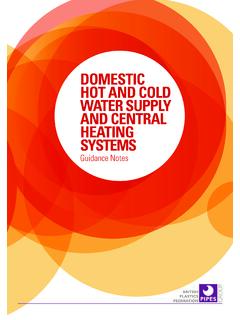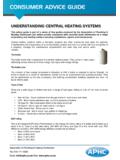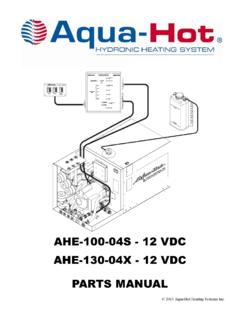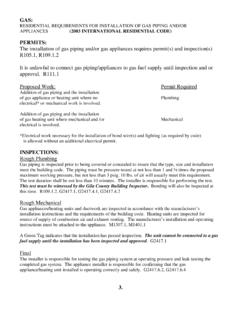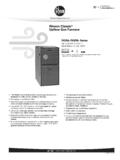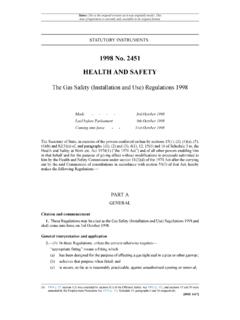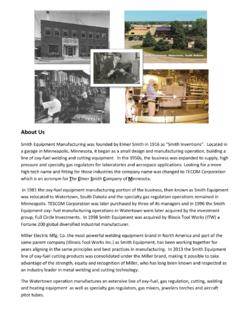Transcription of JS1 L7116 P71 G111 X71 CI/SfB March 2014 …
1 PLASTIC PIPES GROUPGUIDANCE NOTESHOT AND COLD WATER AND CENTRAL heating PLASTIC PIPE SYSTEMS CI/SfB (53) (56) In6 March 2014 Uniclass EPIC JS1 L7116 P71 G111 X712 HOT AND COLD WATER AND CENTRAL heating PLASTIC PIPE SYSTEMSINTRODUCTIONP lastic pipe systems are available in a wide variety of materials. The most common are Polybutylene (PB) and Cross Linked Polyethylene (PEX), including barrier pipe that incorporates an oxygen barrier, and multi-layer composite pipes (MLC). These pipe systems can be used in hot and cold water supply and central heating installations; in fact in most areas where traditional piping materials are flexibility of the pipes, particularly those manufactured in PB or PEX, provides easy handling and installation.
2 They are available in both straight lengths and coils, which enables threading around obstructions and through joists etc., reducing the number of joints required. MLC pipes retain their formed service the systems have many benefits over traditional materials. These include reduction in mechanical noise, no scale build up (as the smooth internal bore reduces the accumulation of limescale), and lack of corrosion. No solder is required (which complies with Water Supply (Water Fittings) Regulations 1999). The pipes do not easily fracture when frozen as thermal expansion is accommodated within the length of a pipe run.
3 Finally, low thermal conductivity means that pipes carrying hot water are cooler to the extensive range of fittings available for each pipe system enables reliable, watertight joints to be made quickly and easily in a wide variety of domestic and commercial pipe systems manufactured from PB and PEX are available Kitemarked to class S of BS 7291-1 (Thermoplastics pipes and associated fittings for hot and cold water for domestic purposes and heating installations in buildings-Part 1:General requirements) which ensures that they are safe for all classes of service conditions shown in table current edition of the standard is dated System Flow Temperature (Tf)Maximum System Service Temperature (Ts) System Malfunction Temperature (Tm)System Maximum Working PressuresAPPLICATIONln C C CBARtIndirect cold water systemsDirect mains-fed cold water systemsSubsurface heating systemsVented hot water systems(1)Unvented hot water systems including instantaneous heaters and/or incorporating storage(1)
4 Vented central heating systems and indirect hot water primary circuitsSealed central heating systems and indirect hot water primary circuits2020-31/22020-12608310031/265831 0031/265951006829510031/2821051143 Table 1 Classification of Service ConditionsKey Table 1l Excludes boiler vent pipesn Excludes discharge pipes from temperature and/or pressure relief valvess Where a nominal working pressure does not compromise an integer value, the mantissa is expressed in a Fractional format. This is done to reduce the possibility of misinterpretation or obscurity that could cause a system to be subjected to an excessive pressuret 1 bar = 105 N/m2 = 105 kPa(1)Continuously operated re-circulating systems are excluded from these applications see page 10 for further detailsCODES OF PRACTICEP lastic pipe systems should be designed and installed in accordance with the following standards and guides:BS 5449:1990 Specification for forced circulation hot water central heating systems for domestic EN 12828:2003 heating systems in buildings.
5 Design for water-based heating EN 12831:2003 heating systems in buildings. Method for calculation of the design heat 5955-8 :2001 Plastics pipework (thermoplastics materials). Specification for the installation of thermoplastics pipes and associated fittings for use in domestic hot and cold services and heating systems in 6700:2006 Specification for design, installation, testing and maintenance of services supplying water for domestic use within buildings and their 8000-15:1990 Workmanship on building sites. Code of practice for hot and cold water services (domestic scale).PAS 33 Specification for the design, installation and commissioning of gas fired central heating systems in domestic premises.
6 Water Industry Act 1991 Water Supply (Water Fittings) Regulations Building Regulations 2000 (approved documents A, G and L).PRODUCT RANGESP lastic pipe systems come in a wide variety of types. Those Kitemarked to Class S of BS 7291 are suitable for the applications described following information provides an outline of the wide choice available in plastic pipe systems. Care should be taken to ensure that the jointing mechanism and fittings used are those recommended by the manufacturer for the pipe systems are available in a range of plastic materials including polybutylene, PPSU and cross-linked polyethylene.
7 Barrier pipes generally have an intermediate polymeric layer bonded to the pipe wall on either side by an adhesive layer that forms a barrier to the passage of oxygen. In MLC systems an intermediate layer of metal, such as aluminium is bonded between the two plastic are available in nominal diameters of 10 to 110mm to cover a wide range of applications. Different manufacturers supply different size are available as straight lengths or coils. Coiled pipes are supplied in longer lengths, which can be threaded in continuous runs through the fabric of a building reducing the number of joints wide variety of fittings are available to cater for all installation requirements.
8 Manufacturers also offer their own range of accessories such as conduit pipe, pipe clips, pipe clip spacers, cold forming bends, pipe cutters etc. The manufacturers brochures should be consulted for the full range of fittings available for each system and their compatibility with other SYSTEMSA variety of jointing systems are available for plastic pipe systems. Care should be taken to ensure that the correct jointing mechanism for the system is used. To ensure the jointing system is compatible, the relevant manufacturer s literature should be consulted. The most common jointing system in the UK for domestic applications is the push-fit.
9 A support sleeve is inserted into the pipe end and the pipe simply pushed firmly into the fitting to an insertion mark or specified depth. A quick tug back on the pipe ensures the joint is secure. Push fit joints incorporate a rubber seal and a gripping mechanism to provide a secure mechanical connection. They are generally demountable either by unscrewing or by using a special systems include Mechanical compression jointing the fitting compresses the pipe ensuring the tightness of the joint without the use of any sealing material. Special tools are sometimes required and a support sleeve should always be used.
10 Press fit jointing incorporating a metal outer sleeve and plastic or metal body with integral inserts. Using a special power tool the outer sleeve is pressed to grip the pipe to the fitting body. Fusion jointing the pipe and fitting are heated until their surfaces melt. The two molten surfaces are brought together and joined. As they cool the two surfaces fuse together. Special tools are required. Electrofusion similar to the above but electrofusion is used to melt the information on installing plastic pipe systems is given below. However, the manufacturer s installa-tion instructions should always be followed for each specific system.
